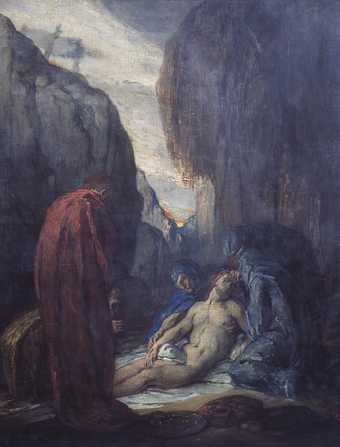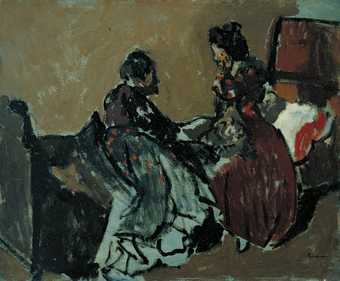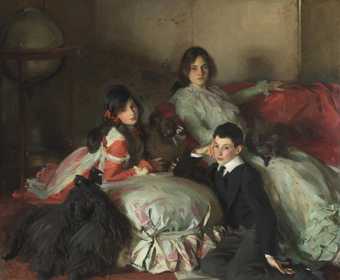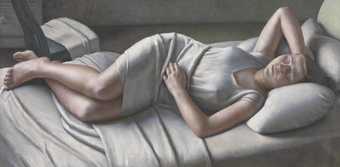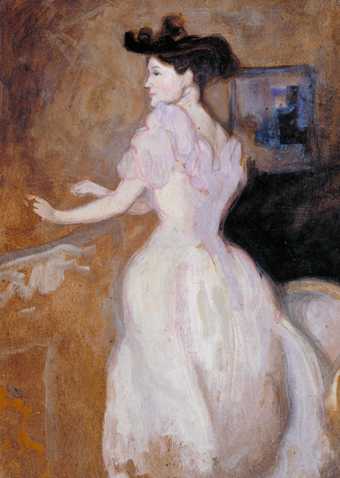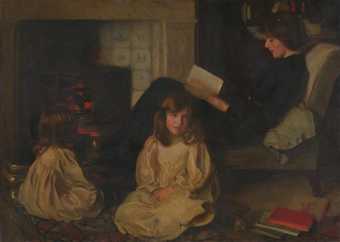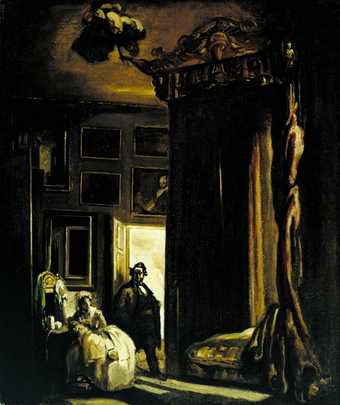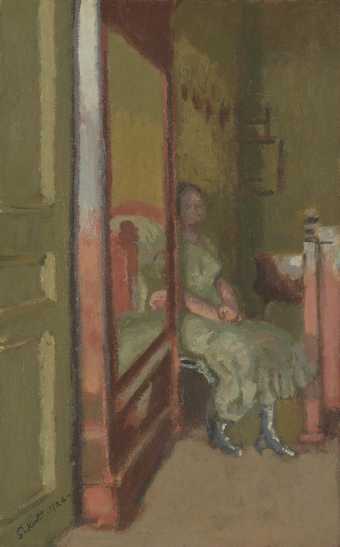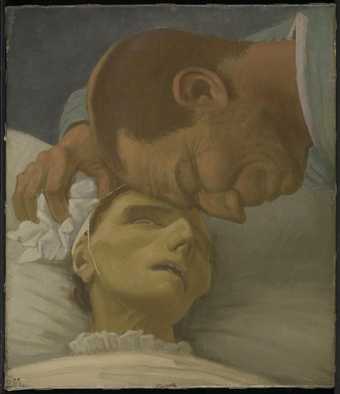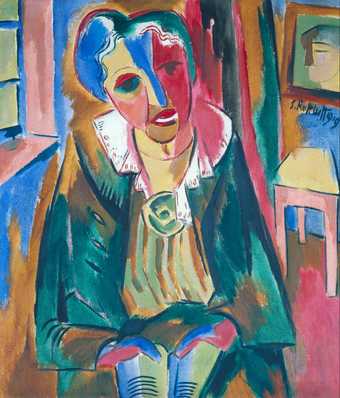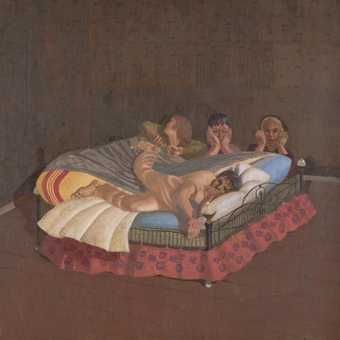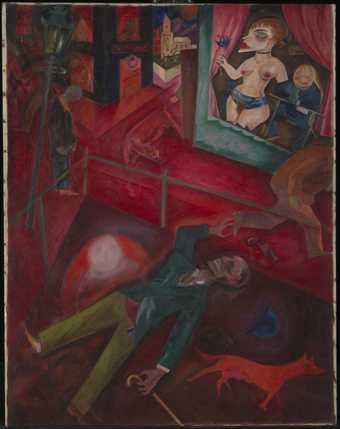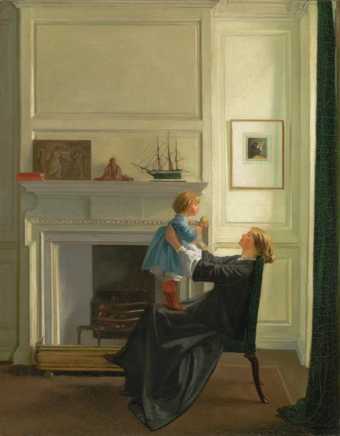
Not on display
- Artist
- Edvard Munch 1863–1944
- Original title
- Det syke barn
- Medium
- Oil paint on canvas
- Dimensions
- Support: 1187 × 1210 mm
frame: 1371 × 1393 × 108 mm - Collection
- Tate
- Acquisition
- Presented by Thomas Olsen 1939
- Reference
- N05035
Display caption
The Sick Child draws upon Munch’s memory of his sister Sophie’s death from tuberculosis at the age of fifteen. The model was a young girl who Munch had observed sitting distraught when he accompanied his father, a doctor, to treat her brother’s broken leg. Munch worked on the painting for a year, developing the rapid brushwork and vivid colour that suggest the painful evocation of a traumatic memory. ‘It was a breakthrough in my art’, he later wrote. ‘Most of what I have done since had its birth in this picture’. He made several versions over a period of forty years. This was the fourth version.
Gallery label, January 2019
Does this text contain inaccurate information or language that you feel we should improve or change? We would like to hear from you.
Catalogue entry
Edvard Munch 1863-1944
N05035 The Sick Child 1907
Inscribed 'E. Munch' b.l. and 'Edv. Munch' b.r.
Oil on canvas, 46 3/4 x 47 5/8 (118.5 x 121)
Presented by Thomas Olsen 1939
Prov:
Gemäldegalerie, Dresden (purchased from the artist 1928); with Harald Holst Halvorsen, Oslo, 1938; Thomas Olsen, Oslo, 1939
Exh:
Internationale Kunst Ausstellung, Dresden, June-September 1926 (244, repr.); Edvard Munch, Kunsthalle, Mannheim, November 1926-January 1927 (35, repr.) as 'Krankes Mädchen (vierte Fassung)' 1907; Nationalgalerie, Berlin, March-May 1927 (112, repr.); Nasjonalgalleriet, Oslo, June 1927 (165, repr.); Edv. Munchs tyske museumsmalerier, Halvorsen, Oslo, January 1939 (40, repr.)
Lit:
Jens Thiis, Edvard Munch og hans Samtid
(Oslo 1933), pp.132-8; Frederick B. Deknatel, Edvard Munch (New York 1950), pp.10, 12; Aftenposten, 1 February 1954 (evening edition); Arne Eggum, 'The Theme of Death' in exh. catalogue Edvard Munch: Symbols and Images, National Gallery, Washington, DC, 1978, pp.143-53, 180-1
Repr:
Studio, CXXXI, 1946, p.176; John Rothenstein, The Tate Gallery (London 1958), p.141 in colour; Jean Selz, Edvard Munch (Naefels 1976), p.72 in colour
This is said to be the fourth of the six versions in oil of this subject. There are also three related prints: an etching of 1894 (Willoch, No.7; Schiefler, No.7); a second etching of the head alone, 1896 (Willoch, No.47; Schiefler, No.60); and a coloured lithograph, 1896 (Schiefler, No.59).
The painted versions are as follows:
1. Nasjonalgalleriet, Oslo 1885-6 (partly overpainted in the 1890s)
2. Konstmuseet, Gothenburg 1896
Painted in Paris when Munch made the colour lithograph of this subject with the printer Clot.
3. Thielska Galleriet, Stockholm 1907
Commissioned by the Swedish banker Ernst Thiel in the spring of 1907 and painted at Warnemünde. On 30 June 1907 Munch wrote to Thiel 'in a few days "The Sick Child" will arrive from Nörregaard, so I can make a start'.
4. The Tate Gallery 1907
Stated in the catalogues of the Munch retrospective exhibition at Mannheim, Berlin and Oslo in 1926-7 to be the fourth version and dated 1907. Arne Eggum writes (letter of 17 October 1977) that Munch stated in a late note that he painted two copies of 'The Sick Child' at Warnemünde in 1907, one for Dr Thiel (which would be the version now in the Thielska Galleriet) and the other for Mr Schou. However Mr Schou originally owned the version in the Konstmuseet, Gothenburg, which is signed and dated 1896. There is photographic evidence that Munch painted the version for Dr Thiel at Warnemünde in 1907, and in the same photograph it seems possible to identify the version which is now at the Tate. Thus Arne Eggum believes that Munch must either have remembered wrongly about painting a copy for Mr Schou in Warnemünde, or the Tate version was originally intended for him.
It has sometimes been suggested by past curators of the Munch Museum that the Tate's version was painted in 1916, but there seems to be no evidence for this other than a tradition that Munch painted one version of 'The Sick Child' in that year.
5. Oslo Municipal Collections, No.51 1925 or earlier
This picture is sometimes tentatively dated 1916, because of the tradition just mentioned, but Arne Eggum believes that it may have been done later. The first definite proof of its existence is a photograph of Munch's studio at Ekely taken in 1925.
6. Oslo Municipal Collections, No.52 1927
Though this work is signed and dated 1926, the inscription was not added until after it had been exhibited at the Carnegie Institute in 1933 and seems to be incorrect. In a draft of a letter to Jens Thiis, Munch says that he painted the fifth (sic) version of 'The Sick Child' during the exhibition at the Nasjonalgalleriet, Oslo, in 1927.
There is also a colour chalk sketch on cardboard of c.1896 in a private collection.
The Tate's painting with its vivid green and red contrasts is bolder in colour than the earlier versions, and has larger brushstrokes.
The theme, together with that of 'Spring' of 1889 and several other paintings of later date, is said to have been inspired by the illness of Munch's elder sister Johanne Sofie, who died from tuberculosis in 1877 at the age of fifteen. The theory that 'The Sick Child' has some reference to his personal background is supported by the fact that Munch painted the earliest version not in his studio, but in the bedroom of his father's flat in Oslo, Schous Plass No.1. Munch's mother had died when the children were very small, and the woman by the bedside is Karen Bjølstad, the aunt who looked after the family in her stead.
It seems, however, that it would be rash to identify the sick child with Sofie without making reservations. The model for the child was a girl with red hair named Betzy Nielsen, who in 1885 was aged eleven. She had her eightieth birthday on 3 February 1954. On 1 February 1954 the Oslo newspaper Aftenposten
(evening edition) published an interview with her in which she gave information that throws a new light on the first version of this work. Munch's father was a doctor in the east end of Oslo, and in the winter of 1885 he was called to the house of Betzy's parents, because her five-year-old brother had broken his leg. Edvard accompanied his father on this visit, and while the doctor was occupied with the patient, Edvard watched Betzy, who was sitting in a chair in the same room, broken down with grief over the pain of her small brother. Before they left, Edvard asked Betzy's mother to be allowed to paint her daughter, and was given permission to do so. She posed for 'The Sick Child' (1885-6), 'The Girl with Red Hair' (1885), 'The Girl with a Tame White Rat' (1886) and 'Spring' (1889).
Probably, therefore, the two incidents in some way fused: the sight of Betzy in her despair reminded him of the sickness and death of Sofie eight years before.
Munch himself has written at some length about 'The Sick Child' in a statement published in his booklet Livsfrisens tilblivelse (The Origin of the Frieze of Life), Oslo c.1929. His words 'When I saw the sick child for the first time - the pale head with the very red hair against the white pillow' imply again that he was 'inspired' by Betzy. Johanne Sofie seems not to have had red hair. The statement is concerned mainly with the difficulties which he experienced in retaining the first impression - 'the trembling mouth - the transparent skin - the tired eyes' -in the course of painting. He said: 'I scraped off half the background and let everything stand in masses ... I also discovered that my own eyelashes had their part in the pictorial impression. I therefore faintly indicated them as shadows across the picture. In a way, the head became the picture. Wavy-lines emerged in the picture - peripheries - with the head as centre ... I painted 3 different [versions]. They are all dissimilar and each makes its special contribution to the first impression ... In the sick child I opened for myself a new path - it was a breakthrough in my art. Most of what I have done since had its birth in this picture'. The first version of 'The Sick Child' represented in fact a new departure in his art, and estranged the majority of the critics, who until then had been favourable.
Munch was one of the artists whose works were condemned by the Nazis as 'degenerate art'. All works by him from German museums (including this picture, from the Dresden Gallery) were collected in the Schloss Schönhausen, Berlin, and sold in November 1938 to foreign dealers.
This picture also has a circular stamp on the stretcher of the 'Göteborgs Tullbehandlings Expedition', evidently a dispatching office for rolled-up bundles (tull). Munch exhibited several times in Gothenburg, notably in 1923 when he showed 28 paintings, but it has not been possible to identify which exhibition this refers to.
(This entry has been compiled with the help of Arne Brenna, Arne Eggum and Carla Lathe).
Published in:
Ronald Alley, Catalogue of the Tate Gallery's Collection of Modern Art other than Works by British Artists, Tate Gallery and Sotheby Parke-Bernet, London 1981, pp.548-50, reproduced p.548
Explore
- emotions, concepts and ideas(16,416)
-
- emotions and human qualities(5,345)
-
- grief(125)
- furnishings(3,081)
-
- bed(401)
- girl(1,079)
- consumption(7)
- illness(185)
- individuals: female(1,698)
- birth to death(1,472)
-
- death(685)
You might like
-
Charles Ricketts Deposition from the Cross
exhibited 1915 -
Walter Richard Sickert A Marengo
c.1903–4 -
John Singer Sargent Essie, Ruby and Ferdinand, Children of Asher Wertheimer
1902 -
Dod Procter Morning
1926 -
Margaret Barker Any Morning
exhibited 1929 -
Charles Conder Portrait Study
c.1901–6 -
Harrington Mann The Fairy Tale
1902 -
James Pryde The Doctor
exhibited 1909 -
Walter Richard Sickert L’Armoire à Glace
1924 -
Henry Lamb Death of a Peasant
1911 -
Karl Schmidt-Rottluff Dr Rosa Schapire
1919 -
Sir Stanley Spencer The Centurion’s Servant
1914 -
Hilda Carline Self-Portrait
1923 -
George Grosz Suicide
1916 -
Sir William Rothenstein Mother and Child
1903

